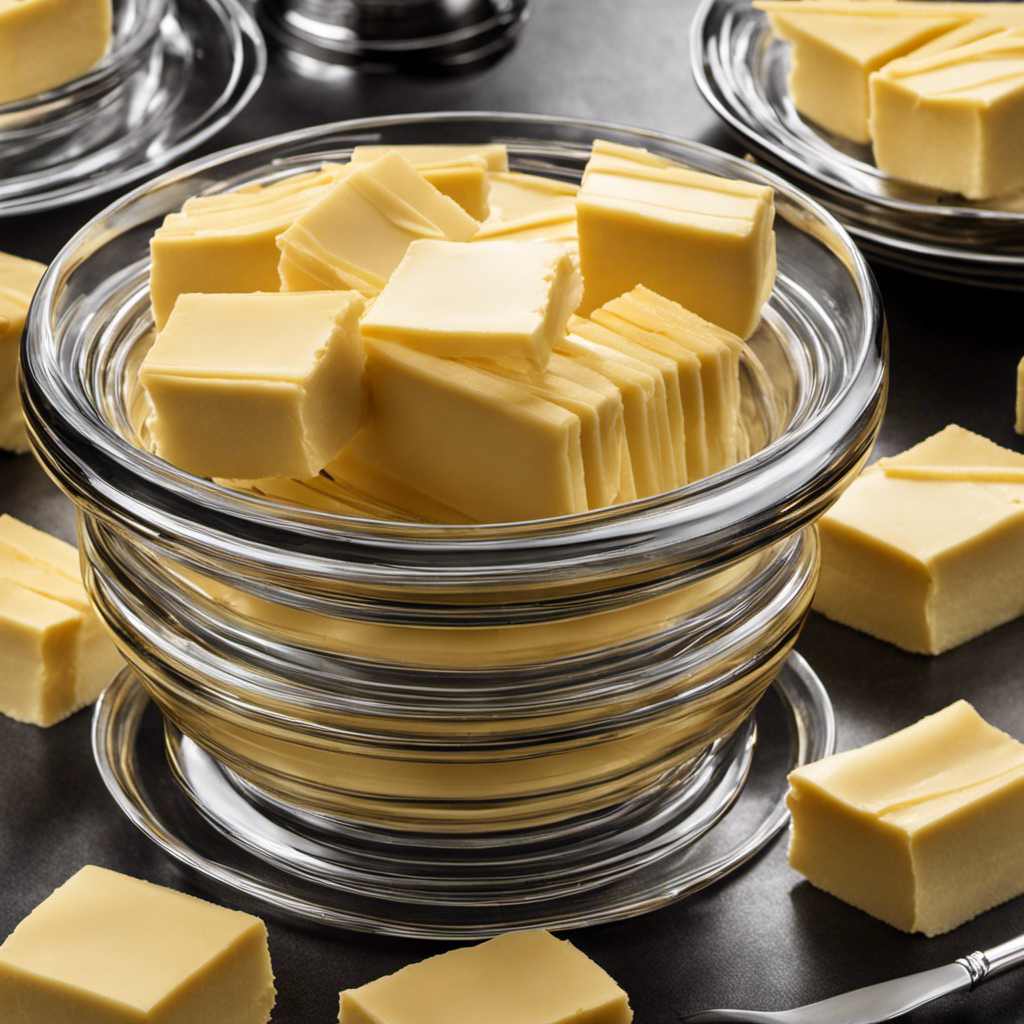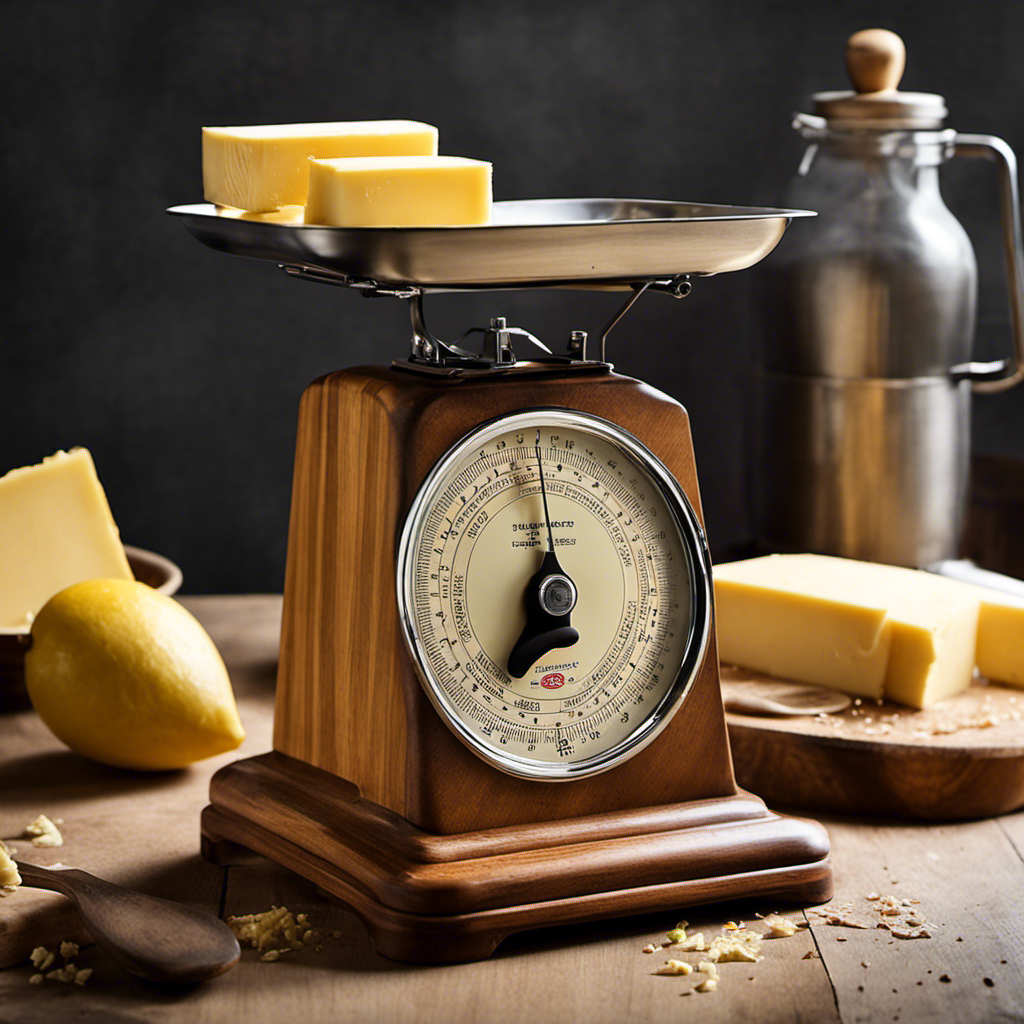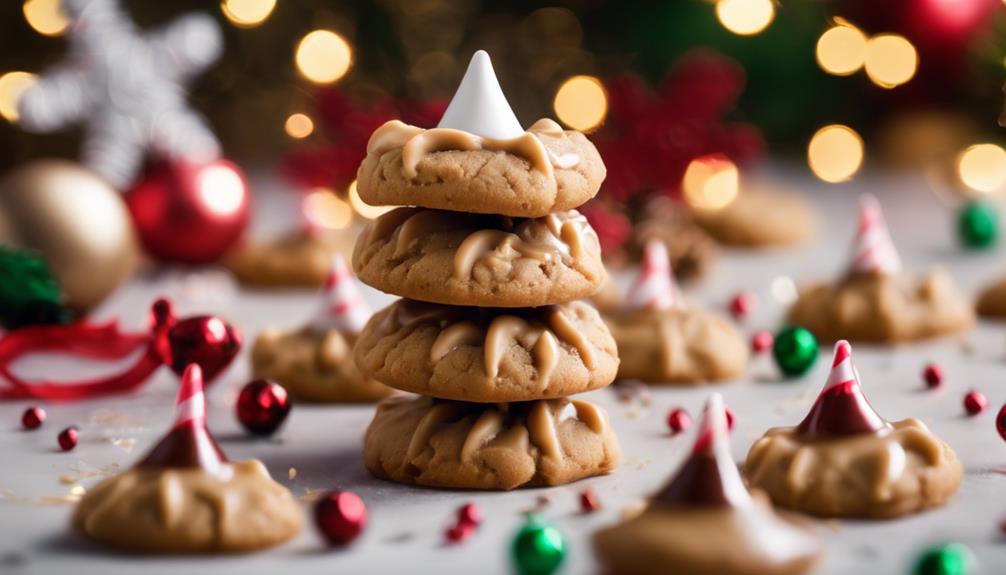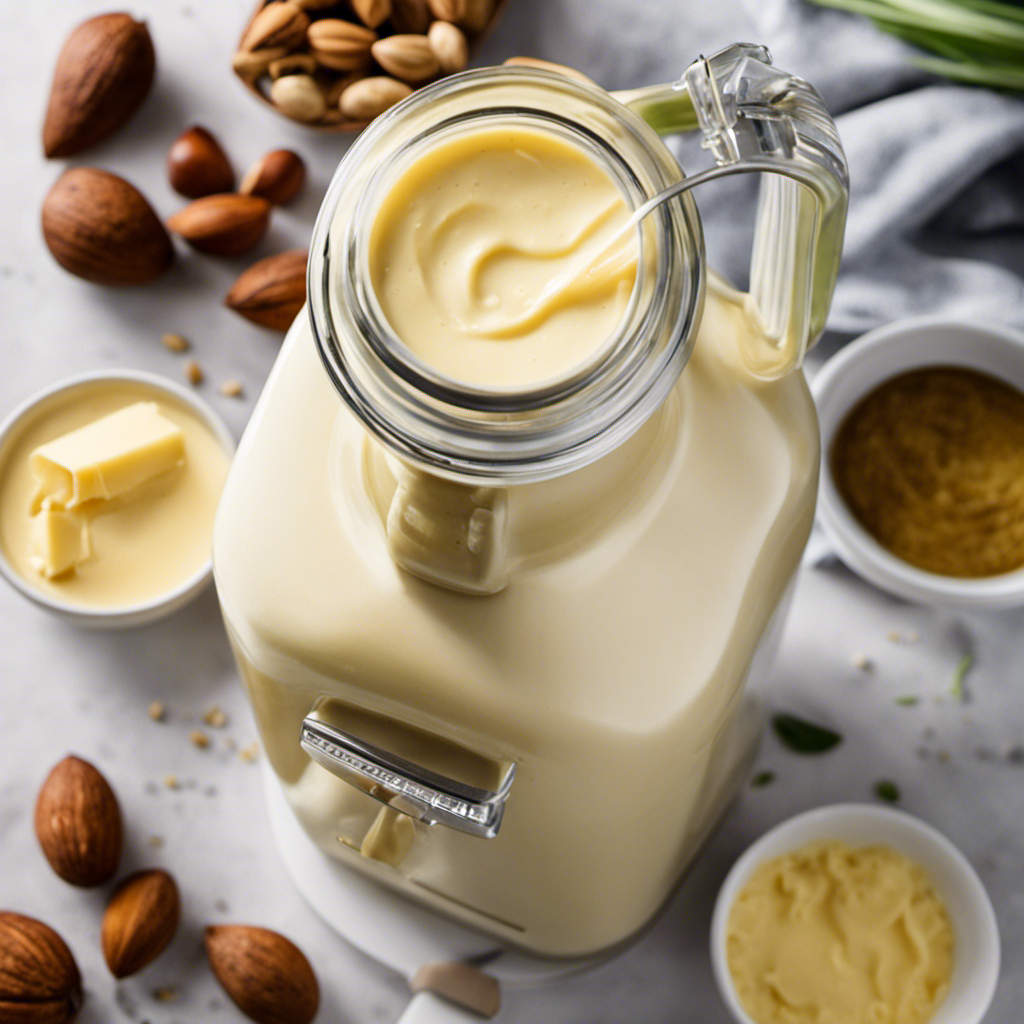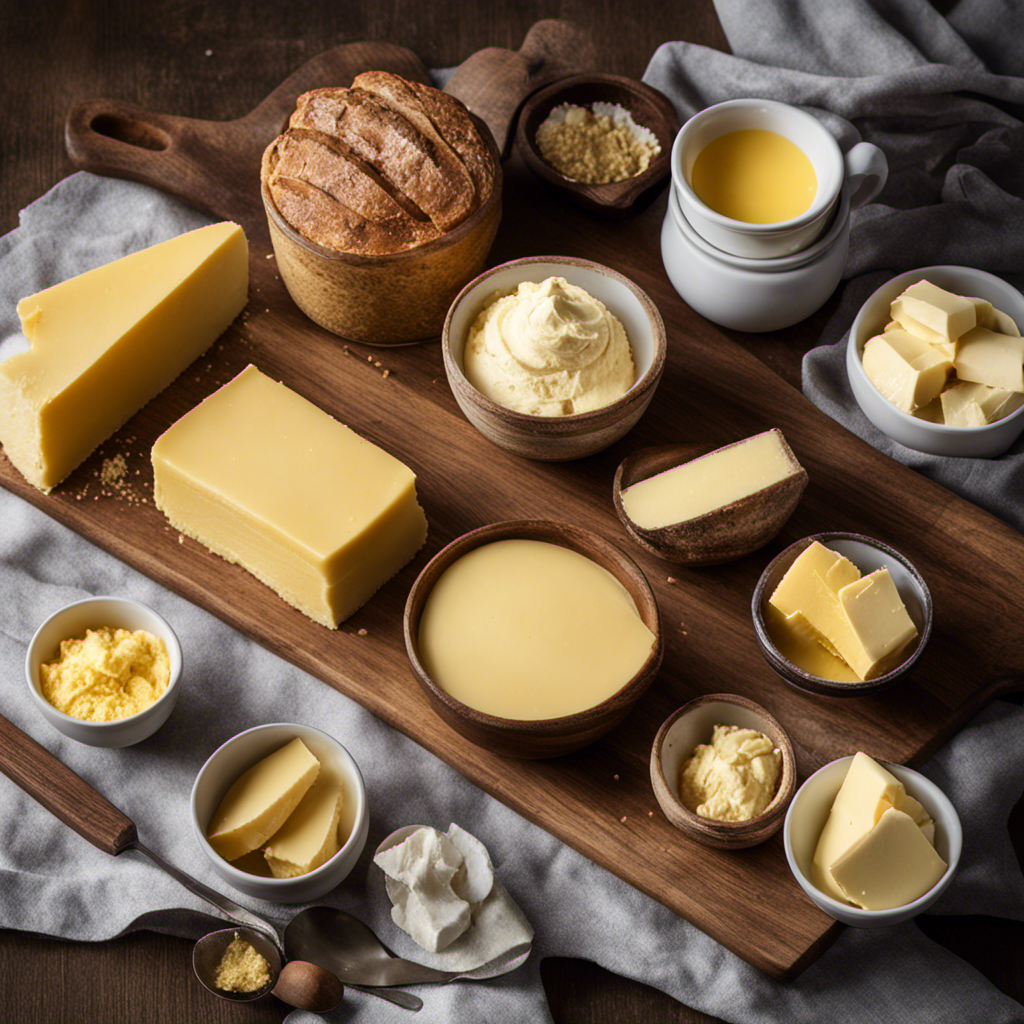As a baker who bakes at home, I frequently ponder the question of how many sticks of butter make up a pound. This information is essential when following recipes and aiming for the desired texture and flavor.
In this article, we’ll explore the conversion ratio of sticks of butter to pounds, delve into the world of butter packaging and measurements, and provide you with common conversions for baking.
So, let’s dive in and uncover the secrets of accurate butter measurement!
Key Takeaways
- The common conversion ratio is 4 sticks of butter to 1 pound.
- 1 pound of butter is equivalent to 4 sticks.
- 2 sticks of butter is half a pound.
- 1 cup of butter is equal to 2 sticks or 16 tablespoons.
Conversion Ratio: Sticks of Butter to Pounds
There’s a common conversion ratio of 4 sticks of butter to 1 pound. This ratio is widely used in cooking and baking. It helps to know this conversion when following recipes that call for butter in pounds or sticks.
For example, if a recipe requires 1 pound of butter, you can easily determine that it is equivalent to 4 sticks. Similarly, if a recipe calls for 2 sticks of butter, you can calculate that it is half a pound.
It’s important to note that butter should be stored properly to maintain its freshness. To keep butter at its best, store it in the refrigerator in an airtight container. You can also freeze butter for longer storage, but make sure to wrap it tightly in foil or freezer-safe bags to prevent freezer burn.
Butter Packaging and Measurements
To figure out how much butter is in a pound, you’ll need to know how the packaging and measurements are done. Butter packaging design and the types of butter sold can vary, but here are some common factors to consider:
- Butter is typically sold in sticks, which are usually wrapped in wax paper or foil.
- Each stick of butter is usually 1/2 cup or 8 tablespoons.
- Butter can also be sold in blocks or tubs, which may have different measurements indicated on the packaging.
- European butter is often sold in 250g blocks, which is slightly less than 1/2 pound.
- Some butter packaging may also include weight measurements in grams.
Understanding the different packaging options and measurements is important when converting butter for recipes.
Now, let’s explore some common butter conversions for baking.
Common Butter Conversions for Baking
If you’re looking to convert butter for baking, a common measurement is 1 cup of butter, which is equal to 2 sticks or 16 tablespoons.
When it comes to butter measurement tips, it’s important to know these conversions to ensure accurate results in your recipes. Converting butter measurements can be crucial in achieving the right texture and flavor in your baked goods.
Understanding the equivalencies can save you time and effort in the kitchen. For example, if a recipe calls for 1/2 cup of butter, you can simply use 1 stick of butter. Similarly, if you need 1/4 cup of butter, you can use half a stick or 4 tablespoons.
Knowing these conversions will help you navigate through various baking recipes with ease and confidence.
How to Convert Sticks of Butter to Pounds
Converting sticks of butter to pounds can be done by multiplying the number of sticks by 0.25. This is a simple and quick calculation that allows you to easily convert butter measurements. However, it’s important to note that different butter types may have slight variations in weight.
To accurately measure butter, you can use the following tools:
- Kitchen scale: This is the most precise way to measure butter, as it gives you an exact weight.
- Measuring cups: Use a liquid measuring cup for softer butters, and a dry measuring cup for harder butters.
- Butter dish: Some butter dishes have markings on the side, indicating the weight of the butter.
Tips for Accurate Butter Measurement
For more precise measurements, you can try using a kitchen scale to accurately measure the weight of your butter. This is especially helpful when you need to soften a specific amount of butter for baking or cooking.
Softening butter is crucial for achieving the right texture and consistency in your recipes. If you don’t have a kitchen scale, there are alternative measurements you can use.
One stick of butter typically weighs around 113 grams or 4 ounces. So, if you need half a cup of butter, you can use one stick, and if you need one cup of butter, you can use two sticks.
Remember to let the butter sit at room temperature for about 30 minutes before using it. This will make it easier to work with and ensure even mixing in your recipes.
Frequently Asked Questions
Can I Use Margarine Instead of Butter in Baking Recipes?
Yes, you can use margarine instead of butter in baking recipes. However, keep in mind that margarine may have a different texture when baked compared to butter. Experimentation may be needed to achieve desired results.
How Many Tablespoons Are in a Stick of Butter?
There are 8 tablespoons in a stick of butter. Knowing this conversion is helpful when substituting butter in recipes or when following a recipe that calls for a specific amount of butter in tablespoons.
Is It Possible to Convert Grams of Butter to Pounds?
Converting grams of butter to pounds is possible. However, there is no standard conversion rate for butter from grams to pounds. It depends on the density of the butter.
What Is the Shelf Life of a Stick of Butter?
The shelf life of a stick of butter depends on proper storage. It can last for several weeks in the refrigerator and up to a year in the freezer.
Are There Any Alternative Measurements for Butter Besides Sticks and Pounds?
When it comes to butter, there are alternative measurements besides sticks and pounds. Butter conversion charts can help you determine the right amount for your recipe. It’s important to have accurate measurements for baking.
Conclusion
Given the conversion ratio of 1 pound of butter equaling 4 sticks, it is clear that butter packaging and measurements can be confusing. However, with common conversions for baking and a simple method to convert sticks of butter to pounds, achieving accurate measurements is possible.
While it may seem trivial, accurately measuring butter can make a significant difference in the outcome of your baked goods. So, next time you reach for that stick of butter, remember the importance of precision and embrace the irony of this seemingly small task.
